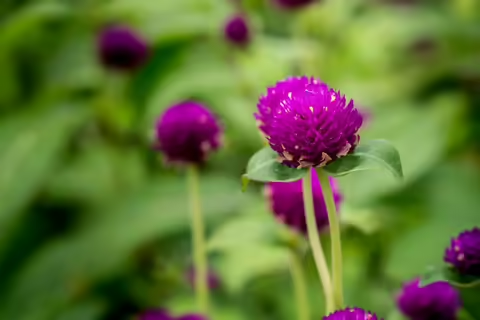URBANA, Ill. – Summer is here and gardens are entering the hot days of August when watering needs dramatically increase and many plants experience stress from the heat.
"Every year, we notice that certain plants are beautiful up until the heat arrives, then fade and wither after repeated hot-weather days," says Martha Smith, University of Illinois Extension horticulture educator. "Plants fade and wither, leaving us with only the memories of what once was."
In recent years, low-water gardening, called xeriscape, is gaining interest. "The term xeriscape often brings visions of parched desert landscapes," says Smith. "Xeriscapes can be colorful, attractive, and inviting while requiring far less water than traditional landscapes."
Smith offers these basic tips to creating a vibrant, low-water garden:
- Group plants according to water needs. Plant thirsty plants in the same area so watering can be concentrated on specific areas.
- Build soil lips or soil basins around plants to direct water to plant roots. Depending on plant size this basin should be 3 to 18 inches from the base of plant.
- Mulching your gardens will help soil retain moisture.
- Pull weeds from beds. Weeds take up water plants could be using.
- Add moisture-holding organic matter if soil drains quickly.
- Pick the right plant for the right spot.
- Choose plants that thrive in hot, dry conditions.
Several plant varieties can survive the hot days of August with very little attention and care except an occasional watering and pruning off of the old blossoms, Smith says. Popular blooming drought-tolerant plants include:
- Celosia or cockscomb (Celosia argentea var. plumosa or C. argentea var. cristata) is unique for its unusual feathery or brain-like flowers of bright red, yellow, orange, and pink. Celosia is an annual that may grow from 6 inches to 4 feet tall depending on the variety. Bring fresh cut celosia inside for an excellent cut flower, or hang it to dry.
- Spider Flower (Cleome hassleriana) can reach 4 to 5 feet tall in full sun. The unique spider-like flowers are rose, violet, or white. Cleome is an annual, meaning it grows from seed every year, and typically re-seeds freely in a garden.
- Gomphrena or Globe Amaranth (Gomphrena globosa) blooms in a variety of bright colors including purple, orange, red, rose, and pink and generally grows 1 to 2 feet tall. The old fashioned annual flower is easy to grow, Smith says, and makes an excellent dried flower that holds its color well. Pick just as the flowers open fully and hang upside down to dry.
- Madagascar Periwinkle or Annual Vinca (Catharanthus roseus) thrives in hot areas. Its lush, dark green foliage is somewhat glossy and forms a 2-foot tall mound. Annual vinca is available in white, pink, purple, and bicolor. This annual works well in areas with southern exposure. It grows slowly in cool spring temperatures and does not tolerate wet areas.
- Threadleaf Coreopsis (Coreopsis verticillata) is a perennial that will reach 18 to 24 inches in height. It has yellow, daisy-like flowers that last from late spring to late summer. It grows best in a dry, full-sun area.
- Orange Coneflower (Rubdeckia fulgida) is the perennial form of Black-eyed Susan. "It's cheery, yellow/orange daisy flowers brighten up the August garden," Smith says.
- Blanket Flower (Gaillardia species) is a perennial available in a variety of hot colors, from golden yellow to mahogany red. Cultivars are available in a range of sizes, with most growing in the 2-foot height range. Blanket Flower tolerates dry soil and temperatures of +90°.
SOURCE: Martha Smith, Horticulture Educator, Illinois Extension
ABOUT EXTENSION: Illinois Extension leads public outreach for the University of Illinois by translating research into action plans that allow Illinois families, businesses, and communities to solve problems, make informed decisions, and adapt to changes and opportunities.
